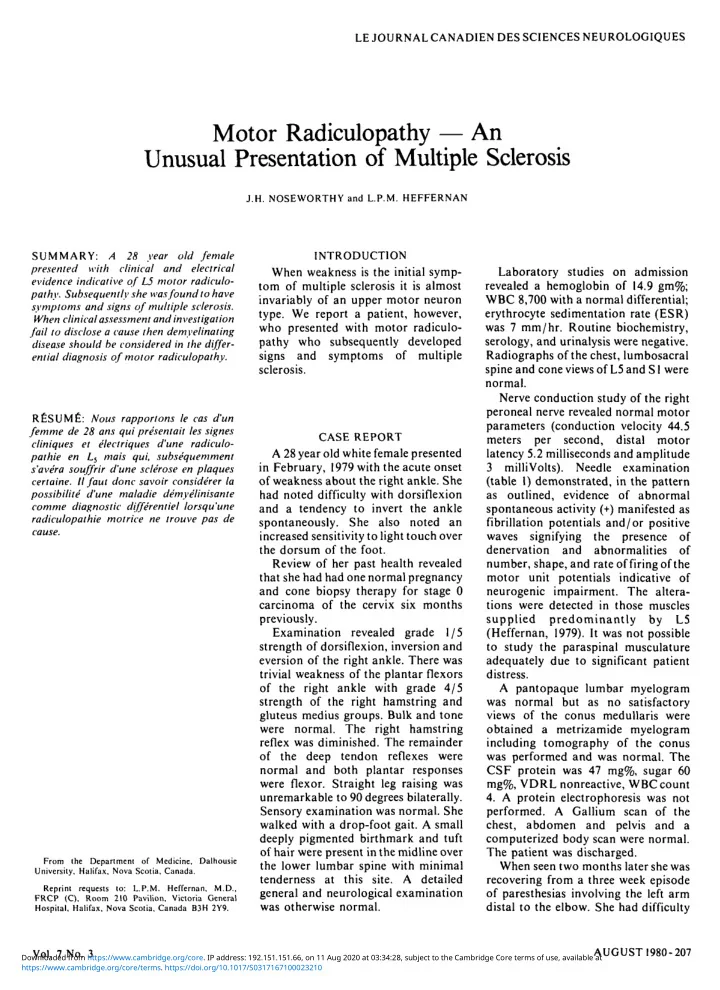

LEJOURNALCANADIENDES SCIENCES NEUROLOGIQUES Motor Radiculopathy — An Unusual Presentation of Multiple Sclerosis J.H. NOSEWORTHY and L.P.M. HEFFERNAN SUMMARY: A 28 year old female INTRODUCTION presented with clinical and electrical When weakness is the initial symp- Laboratory studies on admission evidence indicative of L5 motor radiculo- tom of multiple sclerosis it is almost revealed a hemoglobin of 14.9 gm%; pathy. Subsequently she was found to have invariably of an upper motor neuron WBC 8,700 with a normal differential; symptoms and signs of multiple sclerosis. type. We report a patient, however, erythrocyte sedimentation rate (ESR) When clinical assessment and investigation who presented with motor radiculo- was 7 mm/hr. Routine biochemistry, fail to disclose a cause then demyelinating pathy who subsequently developed serology, and urinalysis were negative. disease should he considered in the differ- signs and symptoms of multiple Radiographs of the chest, lumbosacral ential diagnosis of motor radiculopathy. sclerosis. spine and cone views of L5 and S1 were normal. Nerve conduction study of the right peroneal nerve revealed normal motor RESUME: Nous rapportons le cas d'un parameters (conduction velocity 44.5 femme de 28 ans qui presentait les signes CASE REPORT meters per second, distal motor cliniques et electriques d'une radiculo- latency 5.2 milliseconds and amplitude A 28 year old white female presented pathie en Z. s mais qui, suhse'quemment in February, 1979 with the acute onset 3 millivolts). Needle examination s'avera souffrir d'une sclerose en plaques certaine. II faut done savoir considerer la of weakness about the right ankle. She (table 1) demonstrated, in the pattern possihilite d'une maladie demye'linisante had noted difficulty with dorsiflexion as outlined, evidence of abnormal comme diagnostic differentiel lorsqu'une and a tendency to invert the ankle spontaneous activity (+) manifested as radiculopathie motrice ne trouve pas de spontaneously. She also noted an fibrillation potentials and/or positive cause. increased sensitivity to light touch over waves signifying the presence of the dorsum of the foot. denervation and abnormalities of Review of her past health revealed number, shape, and rate of firing of the that she had had one normal pregnancy motor unit potentials indicative of and cone biopsy therapy for stage 0 neurogenic impairment. The altera- carcinoma of the cervix six months tions were detected in those muscles previously. supplied predominantly by L5 Examination revealed grade 1/5 (Heffernan, 1979). It was not possible strength of dorsiflexion, inversion and to study the paraspinal musculature eversion of the right ankle. There was adequately due to significant patient trivial weakness of the plantar flexors distress. of the right ankle with grade 4/5 A pantopaque lumbar myelogram strength of the right hamstring and was normal but as no satisfactory gluteus medius groups. Bulk and tone views of the conus medullaris were were normal. The right hamstring obtained a metrizamide myelogram reflex was diminished. The remainder including tomography of the conus of the deep tendon reflexes were was performed and was normal. The normal and both plantar responses CSF protein was 47 mg%, sugar 60 were flexor. Straight leg raising was mg%, VDRL nonreactive, WBC count unremarkable to 90 degrees bilaterally. 4. A protein electrophoresis was not Sensory examination was normal. She performed. A Gallium scan of the walked with a drop-foot gait. A small chest, abdomen and pelvis and a deeply pigmented birthmark and tuft computerized body scan were normal. of hair were present in the midline over The patient was discharged. the lower lumbar spine with minimal From Ihe Department of Medicine. Dalhousie When seen two months later she was University, Halifax, Nova Scotia, Canada. tenderness at this site. A detailed recovering from a three week episode general and neurological examination Reprint requests to: L.P.M. Heffernan. M.D., of paresthesias involving the left arm FRCP (C), Room 210 Pavilion, Victoria General was otherwise normal. Hospital, Halifax, Nova Scotia, Canada B3H 2Y9. distal to the elbow. She had difficulty AUGUST 1980-207 Vol. 7 No. 3 Downloaded from https://www.cambridge.org/core. IP address: 192.151.151.66, on 11 Aug 2020 at 03:34:28, subject to the Cambridge Core terms of use, available at https://www.cambridge.org/core/terms. https://doi.org/10.1017/S0317167100023210
Recommend
More recommend